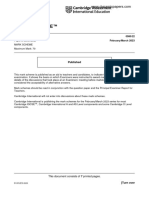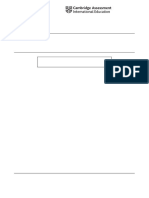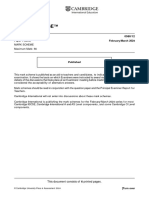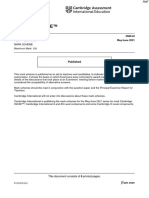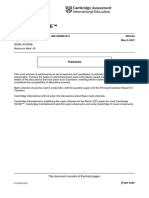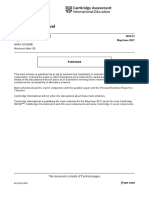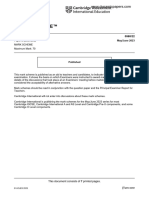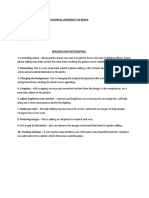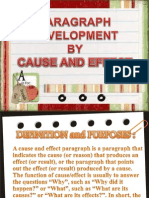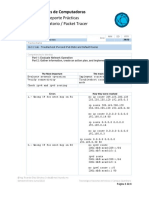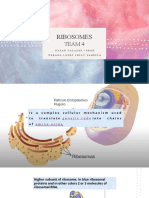Cambridge IGCSE™: Subject 0580/21 May/June 2022
Cambridge IGCSE™: Subject 0580/21 May/June 2022
Uploaded by
azzahrah1266Copyright:
Available Formats
Cambridge IGCSE™: Subject 0580/21 May/June 2022
Cambridge IGCSE™: Subject 0580/21 May/June 2022
Uploaded by
azzahrah1266Original Title
Copyright
Available Formats
Share this document
Did you find this document useful?
Is this content inappropriate?
Copyright:
Available Formats
Cambridge IGCSE™: Subject 0580/21 May/June 2022
Cambridge IGCSE™: Subject 0580/21 May/June 2022
Uploaded by
azzahrah1266Copyright:
Available Formats
www.dynamicpapers.
com
Cambridge IGCSE™
SUBJECT 0580/21
Paper 2 (Extended) May/June 2022
MARK SCHEME
Maximum Mark: 70
Published
This mark scheme is published as an aid to teachers and candidates, to indicate the requirements of the
examination. It shows the basis on which Examiners were instructed to award marks. It does not indicate the
details of the discussions that took place at an Examiners’ meeting before marking began, which would have
considered the acceptability of alternative answers.
Mark schemes should be read in conjunction with the question paper and the Principal Examiner Report for
Teachers.
Cambridge International will not enter into discussions about these mark schemes.
Cambridge International is publishing the mark schemes for the May/June 2022 series for most
Cambridge IGCSE, Cambridge International A and AS Level and Cambridge Pre-U components, and some
Cambridge O Level components.
This document consists of 6 printed pages.
© UCLES 2022 [Turn over
0580/21 www.dynamicpapers.com
Cambridge IGCSE – Mark Scheme May/June 2022
PUBLISHED
Generic Marking Principles
These general marking principles must be applied by all examiners when marking candidate answers. They
should be applied alongside the specific content of the mark scheme or generic level descriptors for a question.
Each question paper and mark scheme will also comply with these marking principles.
GENERIC MARKING PRINCIPLE 1:
Marks must be awarded in line with:
the specific content of the mark scheme or the generic level descriptors for the question
the specific skills defined in the mark scheme or in the generic level descriptors for the question
the standard of response required by a candidate as exemplified by the standardisation scripts.
GENERIC MARKING PRINCIPLE 2:
Marks awarded are always whole marks (not half marks, or other fractions).
GENERIC MARKING PRINCIPLE 3:
Marks must be awarded positively:
marks are awarded for correct/valid answers, as defined in the mark scheme. However, credit is given for
valid answers which go beyond the scope of the syllabus and mark scheme, referring to your Team
Leader as appropriate
marks are awarded when candidates clearly demonstrate what they know and can do
marks are not deducted for errors
marks are not deducted for omissions
answers should only be judged on the quality of spelling, punctuation and grammar when these features
are specifically assessed by the question as indicated by the mark scheme. The meaning, however,
should be unambiguous.
GENERIC MARKING PRINCIPLE 4:
Rules must be applied consistently, e.g. in situations where candidates have not followed instructions or in the
application of generic level descriptors.
GENERIC MARKING PRINCIPLE 5:
Marks should be awarded using the full range of marks defined in the mark scheme for the question
(however; the use of the full mark range may be limited according to the quality of the candidate responses
seen).
GENERIC MARKING PRINCIPLE 6:
Marks awarded are based solely on the requirements as defined in the mark scheme. Marks should not be
awarded with grade thresholds or grade descriptors in mind.
© UCLES 2022 Page 2 of 6
0580/21 www.dynamicpapers.com
Cambridge IGCSE – Mark Scheme May/June 2022
PUBLISHED
Maths-Specific Marking Principles
1 Unless a particular method has been specified in the question, full marks may be awarded for any correct
method. However, if a calculation is required then no marks will be awarded for a scale drawing.
2 Unless specified in the question, answers may be given as fractions, decimals or in standard form. Ignore
superfluous zeros, provided that the degree of accuracy is not affected.
3 Allow alternative conventions for notation if used consistently throughout the paper, e.g. commas being
used as decimal points.
4 Unless otherwise indicated, marks once gained cannot subsequently be lost, e.g. wrong working
following a correct form of answer is ignored (isw).
5 Where a candidate has misread a number in the question and used that value consistently throughout,
provided that number does not alter the difficulty or the method required, award all marks earned and
deduct just 1 mark for the misread.
6 Recovery within working is allowed, e.g. a notation error in the working where the following line of
working makes the candidate’s intent clear.
© UCLES 2022 Page 3 of 6
0580/21 www.dynamicpapers.com
Cambridge IGCSE – Mark Scheme May/June 2022
PUBLISHED
Question Answer Marks Partial Marks
1 31 or 37 1
2 399 1
3 2h 57 min 1
4 4.286 cao 2 30
B1 for 4.285[7...] or 4.29 or or 4 72
7
or for correctly rounding their more accurate
decimal to 4sf
5 320 2 M1 for 380.8 ÷ 1.19 oe
6 2 × 2 × 3 × 3 × 5 oe 2 B1 for 2, 2, 3, 3, 5
or M1 for correct factor tree/diagram/table.
7 9
21
and 2
21
oe M1 Allow any correct denominator 21k
1 A1
cao and correct working
3
8(a) 7.2 oe 1
8(b) 2s 2 s 1 2
[±] final answer M1 for t or 2s = at2 or better
a a 2
9 7 y 2 x y final answer
2 B1 for 7 2 xy y 2 or y 14 x 7 y
or 7 y 2 x y seen then spoilt
10(a) –3 1
10(b) 27 – 5n oe final answer 2 B1 for j – 5n or 27 – kn, k ≠0
or for 27 – 5n seen then spoilt
11(a) 4.5 oe 2 8 6
M1 for oe or better
6 QR
11(b) 135 2 6
3
8
3
their 4.5
3
M1 for or or oe
8 6 6
12 162 3 (5 2) 180
M2 for × k where k = 1, 4, 5,
45579
7, 9
or M1 for 180n ÷ (4 + 5 + 5 + 7 + 9) where
n⩾2
or for (5 – 2) × 180 oe
© UCLES 2022 Page 4 of 6
0580/21 www.dynamicpapers.com
Cambridge IGCSE – Mark Scheme May/June 2022
PUBLISHED
Question Answer Marks Partial Marks
13 1.98 × 10100 2 B1 for 200 1098 or 0.02 10100
or answer with figs 198
14 90 3 B2 for 210 or 0.09 km
OR
M1 for speed × time seen
M1 for correct conversion of
both km to m and between h and s
15 –3 1
16 Enlargement 3 B1 for each
1
[sf]
2
[centre] (4, 4)
17 3.37 or 3.367 to 3.368 3 120
M2 for isolating r 3 , e.g. r 3
1 4
or M1 for r 3 80 oe
2 3
If 0 scored SC1 for answer 2.67 or 2.672 to
2.673...
18 [x = ] 38 3 B1 for [x = ] 38
and
[y = ] 22 B2 for [y = ] 22
or M1 for angle ACB = their x
or angle BAD = 60
or angle CBA = 120
19 PQX and alternate 4 B2 for lines 1 and 2 correct
PXQ and [vertically] opposite oe or B1 for line 1 or 2 correct, or both angles
correct
ASA
XB B1 for line 3 correct
B1 for line 4 correct
20(a) 1 1
1.5 or 1
2
20(b) 240 2 M1 for one correct area
21 (1 – q)(1 – a) or (a – 1)( q – 1) 2 B1 for 1 – q – a(1 – q) or 1 – a – q(1 – a) or
final answer better
or correct answer seen and spoilt
22 36 y144 final answer 2 B1 for ky144 or 36 y k final answer k ≠ 0
or correct answer seen and spoilt
© UCLES 2022 Page 5 of 6
0580/21 www.dynamicpapers.com
Cambridge IGCSE – Mark Scheme May/June 2022
PUBLISHED
Question Answer Marks Partial Marks
23(a) [p = ] 4 2 B1 for one correct
[q = ] –6 or x 4 6 or x2 + px + px + p2 [+ q]
2
23(b) –10 and 2 2 M1 for x 4 2 36
or x their 4 30 their 6
2
or for correct method to solve quadratic
e.g. x 10 x 2
24 28 3 M2 for 242 + 122 + 82
or M1 for 242 + 122 or 242 + 82 or 122 + 82
25 16 3 k
oe final answer M2 for w oe
x x
OR
M1 for w j y
c
M1 for y
x
26 5 1 4 1 1 2 2
a + b final answer M1 for AK = a + b or BK a b
3 3 3 3 3 3
M1 for AL (or OK ) = a + their AK oe soi
or OK (or AL ) = b + their AK⃗ oe soi
or BL = a + their AK⃗ oe soi
M1 for a correct route e.g. OL , a + AL , b +
BL
27 (–2, –1) and (6, 7) 4 B3 for x = – 2 and 6
OR
M1 for x 2 3 x 11 x 1 or better
M1 for correct method to solve their quadratic
e.g. x 2 x 6
If 0 scored, SC1 for one correct pair of
coordinates
© UCLES 2022 Page 6 of 6
You might also like
- Cambridge IGCSE™: Mathematics 0580/23 May/June 2020Document7 pagesCambridge IGCSE™: Mathematics 0580/23 May/June 2020CAMILA VELASQUEZ DIAZNo ratings yet
- Regents Exams and Answers Geometry Revised EditionFrom EverandRegents Exams and Answers Geometry Revised EditionNo ratings yet
- Juny SsDocument6 pagesJuny Sswheatseed123No ratings yet
- June 2022 (v1) Ms - Paper 2 Caie Maths IgcseDocument6 pagesJune 2022 (v1) Ms - Paper 2 Caie Maths IgcseKaise Alloudami100% (1)
- Cambridge IGCSE ™: Mathematics 0580/21 October/November 2022Document7 pagesCambridge IGCSE ™: Mathematics 0580/21 October/November 2022Fusion PLAYSNo ratings yet
- Cambridge IGCSE ™: MathematicsDocument7 pagesCambridge IGCSE ™: Mathematicsengsayedsaad54No ratings yet
- November 2022 (v1) MS - Paper 2 CAIE Maths IGCSEDocument7 pagesNovember 2022 (v1) MS - Paper 2 CAIE Maths IGCSEFoggymybroNo ratings yet
- Cambridge IGCSE™: Mathematics 0580/22 February/March 2022Document8 pagesCambridge IGCSE™: Mathematics 0580/22 February/March 2022TrynosNo ratings yet
- Feb:March 22-2msDocument8 pagesFeb:March 22-2mscsg5r7q9t5No ratings yet
- Cambridge IGCSE ™Document5 pagesCambridge IGCSE ™kiaan.0615No ratings yet
- March 2022 (v2) Ms - Paper 2 Caie Maths IgcseDocument8 pagesMarch 2022 (v2) Ms - Paper 2 Caie Maths IgcseShweta VyasNo ratings yet
- Cambridge IGCSE ™: Mathematics 0580/22 October/November 2022Document7 pagesCambridge IGCSE ™: Mathematics 0580/22 October/November 2022Rita SmairatNo ratings yet
- Cambridge IGCSE™: Mathematics 0580/42 March 2021Document10 pagesCambridge IGCSE™: Mathematics 0580/42 March 2021Nyan Lin HsetNo ratings yet
- Cambridge IGCSE™: Mathematics 0580/23 May/June 2022Document8 pagesCambridge IGCSE™: Mathematics 0580/23 May/June 2022hildebrandokNo ratings yet
- JejejejejejejexdddDocument6 pagesJejejejejejejexddd• ᴛᴀɪ ᴛᴀɪ •No ratings yet
- Cambridge IGCSE™: Cambridge International Mathematics 0607/22 February/March 2022Document5 pagesCambridge IGCSE™: Cambridge International Mathematics 0607/22 February/March 2022NandhivarmanNo ratings yet
- Cambridge IGCSE™: Mathematics 0580/22 May/June 2021Document7 pagesCambridge IGCSE™: Mathematics 0580/22 May/June 2021Omar BilalNo ratings yet
- Cambridge IGCSE ™: Mathematics 0580/21Document7 pagesCambridge IGCSE ™: Mathematics 0580/21Samer EmadNo ratings yet
- Cambridge IGCSE™: Mathematics 0580/22 October/November 2021Document7 pagesCambridge IGCSE™: Mathematics 0580/22 October/November 2021ZaidNo ratings yet
- Cambridge IGCSE™: Mathematics 0580/42 May/June 2022Document9 pagesCambridge IGCSE™: Mathematics 0580/42 May/June 2022Muhammad Anas QasimNo ratings yet
- November 2022 (v2) MS - Paper 2 CAIE Maths IGCSEDocument7 pagesNovember 2022 (v2) MS - Paper 2 CAIE Maths IGCSEXD derp02No ratings yet
- 4024 s22 Ms 12 PDFDocument7 pages4024 s22 Ms 12 PDFMurtaza MustafaNo ratings yet
- June 2018 (v2) MS - Paper 2 CIE Maths IGCSEDocument5 pagesJune 2018 (v2) MS - Paper 2 CIE Maths IGCSEVishnu PriyaNo ratings yet
- Cambridge IGCSE ™: Mathematics 0580/12Document6 pagesCambridge IGCSE ™: Mathematics 0580/12enzeyeeNo ratings yet
- June 2021 (v2) MS - Paper 4 CIE Maths IGCSEDocument8 pagesJune 2021 (v2) MS - Paper 4 CIE Maths IGCSEmoitshepindlovu301No ratings yet
- Cambridge IGCSE™: Cambridge International Mathematics 0607/22 March 2021Document5 pagesCambridge IGCSE™: Cambridge International Mathematics 0607/22 March 2021sinojiayogNo ratings yet
- Cambridge IGCSE ™: Mathematics 0580/12 October/November 2022Document6 pagesCambridge IGCSE ™: Mathematics 0580/12 October/November 2022Tamuka MarongaNo ratings yet
- Core Paper Mark SheetDocument7 pagesCore Paper Mark Sheetbob bobNo ratings yet
- 0580 s18 Ms 21 PDFDocument6 pages0580 s18 Ms 21 PDFAliRazaNo ratings yet
- Cambridge IGCSE™: Mathematics 0580/22 March 2021Document7 pagesCambridge IGCSE™: Mathematics 0580/22 March 2021Omar BilalNo ratings yet
- Cambridge IGCSE™: Mathematics 0580/32 March 2021Document8 pagesCambridge IGCSE™: Mathematics 0580/32 March 2021sandhya srinivasanNo ratings yet
- Cambridge IGCSE™: Mathematics 0580/43 May/June 2022Document11 pagesCambridge IGCSE™: Mathematics 0580/43 May/June 2022hildebrandokNo ratings yet
- June 2021 (v3) MS - Paper 4 CIE Maths IGCSEDocument9 pagesJune 2021 (v3) MS - Paper 4 CIE Maths IGCSEparthpawar5124No ratings yet
- Cambridge IGCSE™Document9 pagesCambridge IGCSE™grengtaNo ratings yet
- Cambridge O Level: Mathematics (Syllabus D) 4024/12 May/June 2021Document7 pagesCambridge O Level: Mathematics (Syllabus D) 4024/12 May/June 2021AdeenaNo ratings yet
- Cambridge O Level: Mathematics (Syllabus D) 4024/11 May/June 2021Document7 pagesCambridge O Level: Mathematics (Syllabus D) 4024/11 May/June 2021Kumail AliNo ratings yet
- March 2021 (v2) MS - Paper 4 CIE Maths IGCSEDocument10 pagesMarch 2021 (v2) MS - Paper 4 CIE Maths IGCSEKinisha KohliNo ratings yet
- Cambridge IGCSE™: Mathematics 0580/11 May/June 2021Document6 pagesCambridge IGCSE™: Mathematics 0580/11 May/June 2021m_armoutiNo ratings yet
- Cambridge IGCSE™: Mathematics 0580/21 May/June 2020Document7 pagesCambridge IGCSE™: Mathematics 0580/21 May/June 2020Luis HuangNo ratings yet
- Cambridge IGCSE ™ (9-1) : Mathematics 0980/31 October/November 2022Document8 pagesCambridge IGCSE ™ (9-1) : Mathematics 0980/31 October/November 2022scepticsNo ratings yet
- Cambridge IGCSE™: Mathematics (Us) 0444/21Document6 pagesCambridge IGCSE™: Mathematics (Us) 0444/21hani98970No ratings yet
- Cambridge IGCSE™: Cambridge International Mathematics 0607/22 October/November 2020Document5 pagesCambridge IGCSE™: Cambridge International Mathematics 0607/22 October/November 2020Lorraine Sabbagh100% (1)
- Cambridge IGCSE™: Mathematics 0580/21 May/June 2020Document7 pagesCambridge IGCSE™: Mathematics 0580/21 May/June 2020HarizZaimNo ratings yet
- June 2018 (v1) MS - Paper 4 CIE Maths IGCSEDocument8 pagesJune 2018 (v1) MS - Paper 4 CIE Maths IGCSEreddyhemanya20No ratings yet
- Cambridge Assessment International Education: Mathematics 0626/02 October/November 2018Document6 pagesCambridge Assessment International Education: Mathematics 0626/02 October/November 2018AFRAH ANEESNo ratings yet
- Cambridge IGCSE™: Additional Mathematics 0606/12Document10 pagesCambridge IGCSE™: Additional Mathematics 0606/12Rishwin Singh Sinda a/l Karamjeet SinghNo ratings yet
- Cambridge Assessment International Education: Mathematics 0626/05 May/June 2018Document8 pagesCambridge Assessment International Education: Mathematics 0626/05 May/June 2018AFRAH ANEESNo ratings yet
- p2 - Answer Sheet 2Document7 pagesp2 - Answer Sheet 2aleeza.300020100814No ratings yet
- Cambridge IGCSE™: Mathematics 0580/22Document7 pagesCambridge IGCSE™: Mathematics 0580/22Jahangir KhanNo ratings yet
- Cambridge IGCSE™: Mathematics 0580/42 May/June 2021Document8 pagesCambridge IGCSE™: Mathematics 0580/42 May/June 2021Thiru VeleyudhamNo ratings yet
- Cambridge IGCSE™: Mathematics 0580/23Document8 pagesCambridge IGCSE™: Mathematics 0580/23muroojghazalyNo ratings yet
- 0580 m18 Ms 12Document5 pages0580 m18 Ms 12Aditya ChristiandiNo ratings yet
- Math Practice Simplified: Fractions (Book G): Practice to Mastering FractionsFrom EverandMath Practice Simplified: Fractions (Book G): Practice to Mastering FractionsRating: 5 out of 5 stars5/5 (1)
- GRE Physics Review: Comprehensive Review for GRE Physics Subject TestFrom EverandGRE Physics Review: Comprehensive Review for GRE Physics Subject TestNo ratings yet
- The GE Way Fieldbook: Jack Welch's Battle Plan for Corporate RevolutionFrom EverandThe GE Way Fieldbook: Jack Welch's Battle Plan for Corporate RevolutionNo ratings yet
- Structural Design Portfolio of Jaher Wasim 1Document59 pagesStructural Design Portfolio of Jaher Wasim 1shehabmunsy100% (1)
- Catalogo X10R - 48Document3 pagesCatalogo X10R - 48Walter FormigoniNo ratings yet
- PHOTOJOURNALISMDocument2 pagesPHOTOJOURNALISMJosephNo ratings yet
- Task 1Document15 pagesTask 1HaziNo ratings yet
- Fired HeatersDocument12 pagesFired HeatersSaleem ChohanNo ratings yet
- VPVRDocument3 pagesVPVRAndrei PravăţNo ratings yet
- Rainfall Freq Dist Pacific IslandsDocument115 pagesRainfall Freq Dist Pacific Islandsceice2013No ratings yet
- A History of Christian Doctrine by Hubert Cunliff-Jones Benjamin Drewery (Editors)Document620 pagesA History of Christian Doctrine by Hubert Cunliff-Jones Benjamin Drewery (Editors)Rochansanga100% (3)
- Prevention and Control of Non-Communicable Diseases: Lifestyle-Related Diseases Chronic DiseasesDocument39 pagesPrevention and Control of Non-Communicable Diseases: Lifestyle-Related Diseases Chronic DiseasesMatt Joseph CabantingNo ratings yet
- Detailed Lesson Plan in TLEDocument3 pagesDetailed Lesson Plan in TLEDemy Magaru Calate100% (3)
- Bay Leave DistillationDocument9 pagesBay Leave Distillationcansu sezerNo ratings yet
- Nammcesa 000022 PDFDocument4,766 pagesNammcesa 000022 PDFBasel Osama RaafatNo ratings yet
- Digital-To-Analog Converter - Wikipedia, The Free EncyclopediaDocument8 pagesDigital-To-Analog Converter - Wikipedia, The Free EncyclopediaAnilkumar KubasadNo ratings yet
- How To Become A Radio Amateur - 1932Document30 pagesHow To Become A Radio Amateur - 1932Victor AsterdamNo ratings yet
- How To Write A Research Paper PDFDocument6 pagesHow To Write A Research Paper PDFLaiba AshrafNo ratings yet
- Winkel Bearing Adjustment Re Lube Instructions 0719Document2 pagesWinkel Bearing Adjustment Re Lube Instructions 0719huseyinNo ratings yet
- Plaintiff-Appellee Accused-Appellant: People of The Philippines, Aubrey Enriquez SoriaDocument11 pagesPlaintiff-Appellee Accused-Appellant: People of The Philippines, Aubrey Enriquez SoriaDarla EnriquezNo ratings yet
- Paragraph Development by Cause and EffectDocument38 pagesParagraph Development by Cause and EffectMarie Gonzales42% (12)
- Unit 1: Introduction To PythonDocument184 pagesUnit 1: Introduction To PythonRudrik Bhatt100% (1)
- 16.3.2 LAB Troubleshoot Ipv4 and Ipv6 Static and Default Routes Herrera - Corona - IvanDocument4 pages16.3.2 LAB Troubleshoot Ipv4 and Ipv6 Static and Default Routes Herrera - Corona - IvanIvan Herrera CoronaNo ratings yet
- Metode Role Playing Terhadap Kemampuan Menyelesaikan Soal Cerita Matematika Siswa Tunarungu Kelas IiiDocument8 pagesMetode Role Playing Terhadap Kemampuan Menyelesaikan Soal Cerita Matematika Siswa Tunarungu Kelas IiiHaha HihiNo ratings yet
- Actividad No 2 - Angela Roman ChicaDocument9 pagesActividad No 2 - Angela Roman ChicaTatiana LunaNo ratings yet
- Rajpal Singh: Objective ExperienceDocument2 pagesRajpal Singh: Objective Experiencerajpal kainturaNo ratings yet
- 1 SMDocument18 pages1 SMEklesiaUmbohNo ratings yet
- AziyatDocument7 pagesAziyatASHFAQ AHMADNo ratings yet
- PA5-KM and ICT For PA Outline - Revision 2Document4 pagesPA5-KM and ICT For PA Outline - Revision 2Juliean Torres AkiatanNo ratings yet
- RIBOSOMESDocument10 pagesRIBOSOMESJorge BazánNo ratings yet
- Co-Creation of Quality Service and Service Failures and Service RecoveryDocument31 pagesCo-Creation of Quality Service and Service Failures and Service RecoverycedzmonderoNo ratings yet
- PSY 310 REV MWA-WPS OfficeDocument13 pagesPSY 310 REV MWA-WPS OfficeandrewwanjjaNo ratings yet






